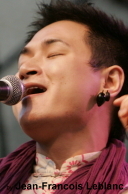Featured artist:
COCO

I once
mentioned to a friend that catching a singer who looks like he
or she is a year or two away from imminent demise, in other words
at his or her performing best, is often a matter of serendipity
-- being at the right venue at the right time. By that standard,
Coco Zhao, who goes by the name of Coco – a marketing strategy
that will not help his career -- whom I caught during the 2006
version of the Montreal
Jazz Festival, sounds and looks like the stuff
of immortality: a glistening shock of black hair, cheeks spun
out of peach fuzz, a smile wider than the sum of the world’s
evil, all of it confidently carried on nimble legs fitted into
pants with enough crotch-drop to shade the ankles. As for the
music, which boldly and credibly fuses elements from both the
pentatonic and diatonic scales (Chinese music and Jazz), it presents
a number of challenges from which careers either break down or
break out.
The
test and reputation of any nation’s art and culture often
depend on their ability to win acceptance in other lands. Unlike
its gastronomy, Chinese or pentatonic composition has not fared
well outside its borders compared to universally embraced Western,
diatonic music – and with good reason. As a physical, tonal
fact, the former, in the key of C, is comprised of only the five
black keys on the piano; it cannot and does not provide the permutational
diversity and precision inherent in the diatonic scale, which,
in C, is comprised of the seven white and five black keys. Given
the choice, most composers and listeners gravitate to the more
interval-rich diatonic mode.
Through
the force of his sincerity and productive imagination, Coco’s
east-west fusion recommends itself, in part, because he refuses
to restrict himself to his pentatonic roots and demonstrates that,
whether in convergence or opposition, both the pentatonic and
diatonic scales are musically compatible. If during the past 20
years, Fusion has degenerated into self-parody -- where the mixing
of unlike genres, regardless of the incompatibility of their elements,
has become its own justification, resulting in a music that at
its best is mannered, at its worst, soporific -- the arrival of
Coco heralds a much needed resuscitation of the original impulse
that inspired the genre’s spectacular emergence (Zawinul,
Pastorius, Clarke, Corea).
If the
first significant example of modern Fusion dates back to Bob Dylan’s
synthesis of Folk, Rock and electric in the mid-1960s, it wasn’t
until Rock & Jazz combined that Fusion gained currency as
a genre, which quickly grew to include the mixing of musics from
unlike cultures, culminating in the great and still unsurpassed
experiments of John McLaughlin and the Shakti albums.
Like Sir John, Coco seamlessly fuses distinct musics and languages,
and despite his westward bent, leaves enough of the pentatonic
in play to satisfy the eastern ear, which, in consideration of
China’s 1.4 billion population and chart-busting marketing
prospects, won't offend Effendi,
Coco’s Montreal label.
Be as
it may that Coco croons mostly in Chinese, as if apologizing for
his diatonic trespassings, he sings with measured passion and
restraint (humility) and intuitively understands that the freedoms
provided by Jazz are only as meaningful as the obstacles imposed
on an ever expanding range of musical choices. Make no mistake
about it: we’re not talking about pentatonically glossed
dinner # 3 music here. Coco’s kid-glove, melifluous vocalese,
supported by a group of sympathetic musicians – which include
Huang Jianyi on piano and Peng Fei on violin -- allow feeling,
and not narrow tradition or loyalty, to choose the right sequence
of notes and textures. And if we concede that Coco is still at
the formative stage of his career, it is no small accomplishment
that his first recording raises more questions and expectations
than enduring results. After all, he is implicitly competing with
the best of Fusion, which may be the only way to arrive at a new
way of thinking about the possibilities of music.
Coco’s
debut CD, Dream Situation, which features interpretations
of mostly Chinese originals, is underscored by its sense of mission
and purposeful colouring and contouring in the shaping of a highly
original music, where depending on mood and moment, the players
can draw from either the Jazz idiom or the Pentatonic Songbook.
Whether or not this east-west meld has enough centripetal gravitas
to become the seed and centre of a new, self-generating musical
constellation remains to be heard.
Listen
to Coco sing "Full Moon, Blooming Flowers"
HERE.